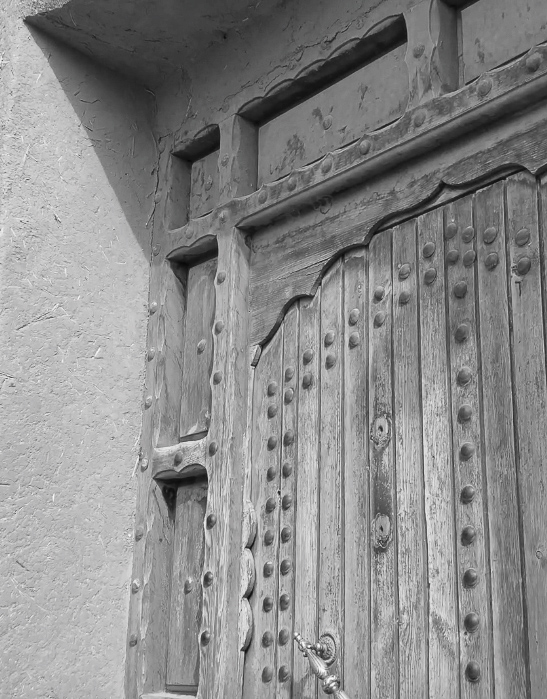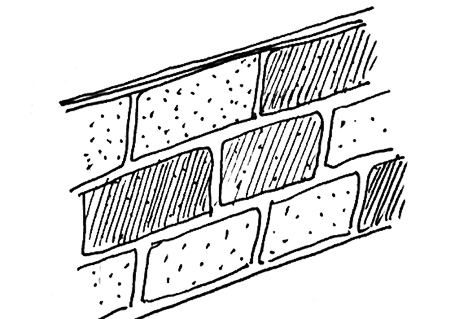15.4. Complex Materials
Aus Pattern Language Wiki
In creating a Biophilic Urbanism, take care that the materials are not too simple and monolithic.
Problem-statement: Too many buildings are made with dull, simple expanses of metal and glass. Repeated endlessly, these materials are ugly.
Discussion:Often the most beautiful materials are also the most complex — that is, they have rich structural divisions within them that can be seen at human scales. Wood, stucco, brick, rusted metal, and other materials have this rich complexity. Perfectly smooth metal, glass, and painted wood panels do not.
In creating healing environments that show fractal scaling, the level smaller than ornament is defined by the microstructure of the materials. Natural materials such as wood and polished stone can reveal wonderful patterns from their former biological structure. Because of fractal scaling, we connect intimately to those smallest scales, from 1 cm down to less than 1 mm. This explains the universal love of expensive natural materials for construction, especially if used in indoor surfaces. But amorphous materials such as concrete, glass, and smooth metal show no organized substructure whatsoever. They don’t satisfy the human craving for organized complexity on the smallest scales.¹ Formwork for concrete could be used towards this end, but good examples are very rare: much more common is a rather unattractive rough gray surface that doesn’t satisfy our basic need for organized complexity.
Therefore:
Avoid large expanses of perfectly flat, smooth panels of metal and glass. Use complex materials that have subtle structural characteristics that can be perceived at human scales.
Use materials like Soft Tile And Brick, and Warm Colors.
¹ See Salingaros, N. A. (1999). Architecture, patterns, and mathematics. Nexus Network Journal, 1(1-2), 75-86.
Mehaffy, M. et al. (2020). COMPLEX MATERIALS (pattern). In A New Pattern Language for Growing Regions. The Dalles: Sustasis Press. Available at https://pattern-language.wiki/.../Complex_Materials
SECTION I:
PATTERNS OF SCALE
1. REGIONAL PATTERNS
Define the large-scale spatial organization…
1.4. 400M THROUGH STREET NETWORK
2. URBAN PATTERNS
Establish essential urban characteristics…
3. STREET PATTERNS
Identify and allocate street types…
4. NEIGHBORHOOD PATTERNS
Define neighborhood-scale elements…
5. SPECIAL USE PATTERNS
Integrate unique urban elements with care…
6. PUBLIC SPACE PATTERNS
Establish the character of the crucial public realm…
7. BLOCK AND PLOT PATTERNS
Lay out the detailed structure of property lines…
8. STREETSCAPE PATTERNS
Configure the street as a welcoming place…
9. BUILDING PATTERNS
Lay out appropriate urban buildings…
10. BUILDING EDGE PATTERNS
Create interior and exterior connectivity…
10.1. INDOOR-OUTDOOR AMBIGUITY
SECTION II:
PATTERNS OF MULTIPLE SCALE
11. GEOMETRIC PATTERNS
Build in coherent geometries at all scales…
11.2. SMALL GROUPS OF ELEMENTS
12. AFFORDANCE PATTERNS
Build in user capacity to shape the environment…
13. RETROFIT PATTERNS
Revitalize and improve existing urban assets …
14. INFORMAL GROWTH PATTERNS
Accommodate “bottom-up” urban growth…
15. CONSTRUCTION PATTERNS
Use the building process to enrich the result…
SECTION III:
PATTERNS OF PROCESS
16. IMPLEMENTATION TOOL PATTERNS
Use tools to achieve successful results…
16.2. ENTITLEMENT STREAMLINING
16.3. NEIGHBORHOOD PLANNING CENTER
17. PROJECT ECONOMICS PATTERNS
Create flows of money that support urban quality…
17.4. ECONOMIES OF PLACE AND DIFFERENTIATION
18. PLACE GOVERNANCE PATTERNS
Processes for making and managing places…
18.3. PUBLIC-PRIVATE PLACE MANAGEMENT
19. AFFORDABILITY PATTERNS
Build in affordability for all incomes…
19.1. INTEGRATED AFFORDABILITY
20. NEW TECHNOLOGY PATTERNS
Integrate new systems without damaging old ones…
20.2. RESPONSIVE TRANSPORTATION NETWORK COMPANY

